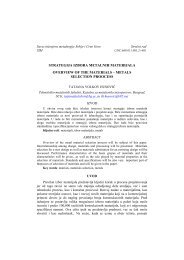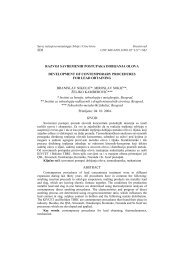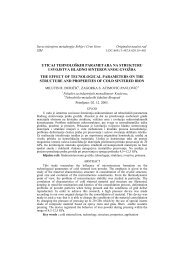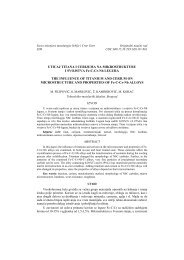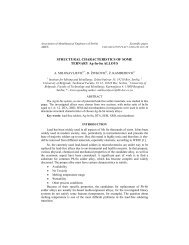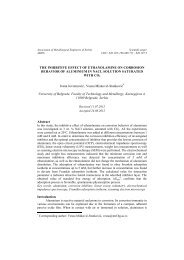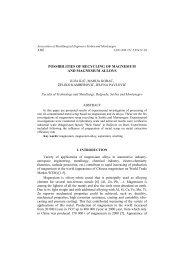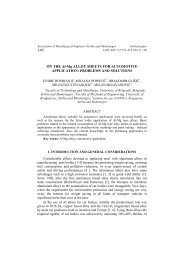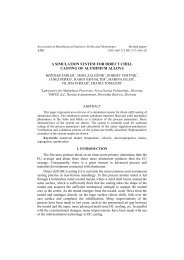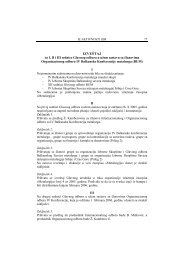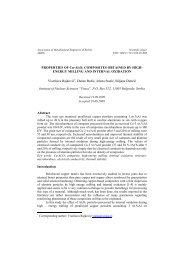EFFECT OF VOLUME FRACTION OF (Cr,Fe)7C3 CARBIDES ON ...
EFFECT OF VOLUME FRACTION OF (Cr,Fe)7C3 CARBIDES ON ...
EFFECT OF VOLUME FRACTION OF (Cr,Fe)7C3 CARBIDES ON ...
You also want an ePaper? Increase the reach of your titles
YUMPU automatically turns print PDFs into web optimized ePapers that Google loves.
Association of Metallurgical Engineers of Serbia<br />
AMES<br />
Scientific paper<br />
UDC: 621.791.5<br />
<strong>EFFECT</strong> <strong>OF</strong> <strong>VOLUME</strong> <strong>FRACTI<strong>ON</strong></strong> <strong>OF</strong> (<strong>Cr</strong>,<strong>Fe</strong>) 7 C 3 <strong>CARBIDES</strong> <strong>ON</strong><br />
CORROSI<strong>ON</strong> RESISTANCE <strong>OF</strong> THE <strong>Fe</strong>-<strong>Cr</strong>-C HARDFACING ALLOYS<br />
AT<br />
<strong>Cr</strong> = 6<br />
C<br />
Hamed Sabet 1∗ , Shamsedin Mirdamadi 2 , Shahram Kheirandish 2 ,<br />
Masoud Goodarzi 2<br />
1 Department of Materials Engineering, Karaj Branch, Islamic Azad University,<br />
Karaj, Iran , P.O. Box: 31485-313<br />
2 School of Materials Engineering, Iran University of Science and Technology,<br />
Tehran, Iran. Z.P: 1648613114<br />
Received 24.09.2012<br />
Accepted 03.01.2013<br />
Abstract<br />
In this investigation, three different chemical compositions of <strong>Fe</strong>-<strong>Cr</strong>-C alloys<br />
were fabricated on AISI 1010 steel substrates by gas tungsten arc welding (GTAW).<br />
The optical emission spectroscopy (OES), optical microscopy (OM), scanning electron<br />
microscopy (SEM), techniques and corrosion test were used for determining chemical<br />
composition studying the microstructure and corrosion behavior of the <strong>Fe</strong>-<strong>Cr</strong>-C alloys.<br />
The OM and SEM results show that the microstructure of these alloys consisted of<br />
(<strong>Cr</strong>,<strong>Fe</strong>) 7 C 3 carbides with austenite, and by increasing of the carbon and chromium<br />
content in hardfacing alloys, the volume fraction of (<strong>Cr</strong>,<strong>Fe</strong>) 7 C 3 carbides in<br />
microstructure was increased. The polarization curves of the corrosion tests show that<br />
the increase of the volume fraction of (<strong>Cr</strong>,<strong>Fe</strong>) 7 C 3 carbides in the microstructure<br />
promotes the corrosion resistance of the <strong>Fe</strong>-<strong>Cr</strong>-C hardfacing alloys. The corrosion<br />
mechanism of the <strong>Fe</strong>-<strong>Cr</strong>-C hardfacing alloys was intergranular and galvanic corrosion.<br />
Keywords: <strong>Fe</strong>-<strong>Cr</strong>-C; <strong>Cr</strong> = 6 ; (<strong>Cr</strong>,<strong>Fe</strong>) 7 C 3 carbides; Austenite; Corrosion resistance<br />
C<br />
Introduction<br />
∗ Corresponding Author: Hamed Sabet, h-sabet@kiau.ac.ir
108 Metall. Mater. Eng. Vol 19 (2) 2013 p. 107-114<br />
The <strong>Fe</strong>-<strong>Cr</strong>-C is the most popular type of hardfacing alloys because it has<br />
relatively low cost than that the others as: <strong>Fe</strong>-Ni-Co (X: carbides forming elements) [1,<br />
2]. The <strong>Fe</strong>-<strong>Cr</strong>-C alloys are used in severe abrasive conditions [3] .The excellent<br />
abrasion wear resistance of the <strong>Fe</strong>-<strong>Cr</strong>-C alloys depends on: type, morphology, volume<br />
fraction, distribution pattern of (<strong>Cr</strong>,<strong>Fe</strong>) 7 C 3 carbides, and the type of matrix structure<br />
around the carbides [3,4].<br />
The three types of carbides such as: M 3<br />
C , M 7C and<br />
3<br />
M23C<br />
in <strong>Fe</strong>-<strong>Cr</strong>-C alloys<br />
6<br />
depend upon the <strong>Cr</strong> ratio. Therefore, this ratio determines the applicability of these<br />
C<br />
alloys in different wear conditions [5, 6]. It was reported [6] that the excellent abrasive<br />
wear resistance with good corrosion and oxidation resistance can be obtained with the<br />
ratio of <strong>Cr</strong> =5-8. In this ratio range, the hypoeutectic, eutectic and hypereutectic<br />
C<br />
structure with the austenite phase is formed including (<strong>Cr</strong>,<strong>Fe</strong>) 7 C 3 carbides [5, 6].<br />
The <strong>Fe</strong>-<strong>Cr</strong>-C alloys are used widely in extractive oil equipments where erosioncorrosion<br />
might cause serious problems. Handling and processing of essentially silicabased<br />
solids results in extremely severe corrosion and wear conditions [7]. A few<br />
investigations were focused on the behavior of the <strong>Fe</strong>-<strong>Cr</strong>-C hardfacing alloys in the<br />
corrosive environments. Buchanan [8 ] reported that the abrasion-corrosion of the <strong>Fe</strong>-<br />
<strong>Cr</strong>-C alloy in an slurry of sand and sugarcane juice was lower than that <strong>Fe</strong>-C-B alloy<br />
and this behavior of the <strong>Fe</strong>-<strong>Cr</strong>-C alloy was due to chromium carbides that exist in the<br />
microstructure. Chang et al. [9] reported that the increment of carbon content can<br />
improve the corrosion resistance of the hypereutectic <strong>Fe</strong>–<strong>Cr</strong>–C cladding alloys and with<br />
increase of the carbon content the corrosion potential is moved towards the noble side.<br />
Although the object of these few papers was to study the corrosion resistance of<br />
the <strong>Fe</strong>-<strong>Cr</strong>-C hardfacing alloys, but their results were not directed solely on the effect of<br />
carbides on the corrosion behavior of these alloys. This study is particularly focused on<br />
the effect of volume fraction of ( <strong>Cr</strong>,<strong>Fe</strong>) 7<br />
C carbides on the corrosion resistance of <strong>Fe</strong>-<br />
3<br />
<strong>Cr</strong>-C hardfacing alloys at <strong>Cr</strong> = 6 .<br />
C<br />
Experimental<br />
AISI 1010 low carbon steel (C=0.1wt.%) specimens with 200×100×10 mm<br />
dimensions were used for the substrate. The surface of the samples were thoroughly<br />
cleaned, dried and rinsed by acetone. The powders mixture (in wt.%) of the<br />
ferrochromium (70 <strong>Cr</strong> and 30 <strong>Fe</strong>) and crystalline graphite (98% purity) were used as a<br />
coating alloys. The ratio of ferro-chromium and graphite powder corresponds to that of<br />
stoich-ometric M C 7 3<br />
carbides.<br />
Three different amounts of the ferrochromium and graphite powders were mixed<br />
in ball mill for 1h in argon atmosphere. Then each mixture of powders was mixed with<br />
20 wt.% sodium silicate, were pre-placed on the substrate with1 mm thickness, and<br />
dried in electrical furnace at 120 o C for 1h.<br />
Hardface cladding was carried out by using the gas tungsten arc welding<br />
(GTAW) heat source to produce series of multiple hardface clad tracks. The chemical<br />
analysis of hardfacing alloy was determined by optical emission spectroscopy (OES).<br />
For metallography, the samples were cut and polished by 1µm diamond paste and
Sabet at al. - Effect of Volume Fraction of (<strong>Cr</strong>,<strong>Fe</strong>) 7 C 3 Carbides on Corrosion ... 109<br />
chemically etched in a freshly prepared 2% nital solution. The microstructure was<br />
observed using a VEGA/TESCAN scanning electron microscope (SEM) equipped with<br />
back-scattered electron (BSE) detectors. In addition, in order to determine the volume<br />
fraction of phases in each sample optical microscope (Olympus BX51 M) equipped<br />
with image analysis software was used.<br />
For corrosion test each sample was covered with the waterproof tape, leaving an<br />
exposed area of 1cm 2 on the material surface. Less than 3.5 wt.% NaCl solution at<br />
30° C was used as a corrosion medium for performing the potentio-dynamic<br />
polarization tests in order to evaluate the overall corrosion behavior of the samples. The<br />
working electrode polarization was measured as a potential difference between the<br />
reference and working electrode. The polarization resistance was measured with<br />
potential scanning rate of 0.5 mVs -1 within the potential rate of E oc ±10mV. The silversilver<br />
chloride electrode was regarded as a reference electrode. After polarization test,<br />
the corroded surface was observed by optical microscope.<br />
Results and Discussion<br />
Table 1 gives the chemical analysis of different hardface samples. Three types of<br />
different <strong>Fe</strong>-<strong>Cr</strong>-C hardfacing alloys were fabricated with the constant ratio of <strong>Cr</strong> ≅ 6 .<br />
C<br />
Table 1 Chemical composition (wt.%) of the hardfacing alloys.<br />
Sample C Si Mn P S <strong>Cr</strong> <strong>Fe</strong> <strong>Cr</strong><br />
C<br />
A 1.94 0.13 0.14 0.002 0.003 12.21 Bal. 6.2<br />
B 3.52 0.13 0.12 0.002 0.003 21.32 Bal. 6.1<br />
C 4.02 0.12 0.13 0.002 0.003 24.22 Bal. 6.0<br />
Fig.1 illustrates the microstructure of hardfacing alloys with different chemical<br />
compositions. ( <strong>Cr</strong>.<strong>Fe</strong>) C carbides and austenite were obtained in all samples. Fig.1<br />
7 3<br />
denotes that sample A has hypoeutectic microstructure with primary austenite and<br />
eutectic ((<strong>Cr</strong>,<strong>Fe</strong>) 7 C 3 +austenite) structure. Sample B has eutectic ((<strong>Cr</strong>,<strong>Fe</strong>) 7 C 3 +austenite)<br />
structure, whereas sample C has hypereutectic microstructure with primary (<strong>Cr</strong>,<strong>Fe</strong>) 7 C 3<br />
and eutectic ( ( <strong>Cr</strong>.<strong>Fe</strong>) C +austenite) structure.<br />
7 3
110 Metall. Mater. Eng. Vol 19 (2) 2013 p. 107-114<br />
Fig.1 SEM micrographs of hardface alloys with different chemical compositions.<br />
Table 2 shows the microstructural characteristics of the different samples. The<br />
results of Table 2 indicate that by increasing of the carbon and chromium contents in the<br />
<strong>Fe</strong>-<strong>Cr</strong>-C hardface alloys, the total volume fraction of (<strong>Cr</strong>,<strong>Fe</strong>) 7 C 3 carbides was increased<br />
and the volume fraction of total austenite was decreased.<br />
Fig.2 shows potentiodynamic polarization curves of hardfacing alloys with<br />
different volume fraction of (<strong>Cr</strong>,<strong>Fe</strong>) 7 C 3 carbides in 3.5wt% NaCl at 30°C.<br />
Table 2 The microstructure characteristics of the different samples<br />
Sample<br />
A<br />
B<br />
C<br />
Chemical<br />
compositio<br />
n (wt.%)<br />
Microstructu<br />
re<br />
Primary Eutectic<br />
C <strong>Cr</strong><br />
austenite austenite<br />
1.94 12.22 hypoeutectic 45 14<br />
3.52 21.32 eutectic - 23<br />
4.02 24.22 hypereutectic - 15<br />
Phases characteristics (wt.%)<br />
Total<br />
austenite<br />
59<br />
23<br />
15<br />
Eutectic<br />
carbide<br />
41<br />
77<br />
40<br />
Primary<br />
carbide<br />
-<br />
-<br />
45<br />
Total<br />
carbide<br />
41<br />
77<br />
85<br />
Total<br />
Phases<br />
100<br />
100<br />
100<br />
Table 3 gives the corrosion current and potential with polarization resistance of<br />
hardfacing alloys. It is clear that when the (<strong>Cr</strong>,<strong>Fe</strong>) 7 C 3 carbides were increased from 41<br />
(sample A) to 85 wt.% (sample C), the values of the corrosion potential (E corr ) was<br />
increased from -594.0 to -486.1 mV, and the values of the corrosion current (I corr ) was<br />
reduced from 34.99 to 1.239 μA, and the values of the polarization resistance (R p ) was<br />
increased from 1.49 to 30.43 Ωcm 2 . The higher R p and E corr or lower I corr indicate that<br />
the corrosion resistance is excellent. Therefore, the best corrosion resistance was<br />
obtained in sample C with total of 85 wt.% (<strong>Cr</strong>,<strong>Fe</strong>) 7 C 3 carbides.
Sabet at al. - Effect of Volume Fraction of (<strong>Cr</strong>,<strong>Fe</strong>) 7 C 3 Carbides on Corrosion ... 111<br />
Fig.2 Potentiodynamic polarization curves of hardfacing alloys with various volume<br />
fraction of (<strong>Cr</strong>,<strong>Fe</strong>) 7 C 3 carbides in 3.5wt% NaCl at<br />
30° C .
112 Metall. Mater. Eng. Vol 19 (2) 2013 p. 107-114<br />
Table 3 The corrosion current (I corr ), corrosion potential (E corr ) and polarization<br />
resistance (R p ) of hardfacing alloys in 3.5wt.% NaCl solution.<br />
Sample<br />
Total<br />
(<strong>Cr</strong>,<strong>Fe</strong>) 7 C 3<br />
E corr<br />
(mV)<br />
I corr<br />
(μ A)<br />
( Ω<br />
R p<br />
2<br />
cm )<br />
A 41% -594.0 34.99 1.49<br />
B 77% -570.0 8.128 7.88<br />
C 85% -486.1 1.239 30.43<br />
The corrosion potential of (<strong>Cr</strong>,<strong>Fe</strong>) 7 C 3 carbides was higher than the austenite<br />
because the (<strong>Cr</strong>,<strong>Fe</strong>) 7 C 3 carbides have excellent chemical stability [10, 11]. (<strong>Cr</strong>,<strong>Fe</strong>) 7 C 3<br />
carbides are corrosion resistant, but the surrounding chromium-depleted alloy in the<br />
matrix (austenite) was aggressively corroded. When the volume fraction of (<strong>Cr</strong>,<strong>Fe</strong>) 7 C 3<br />
carbides was increased, the corroded area (austenite) was decreased. Therefore, the<br />
corrosion resistance of hardfacing alloy (sample C) was enhanced by increasing of the<br />
volume fraction of (<strong>Cr</strong>,<strong>Fe</strong>) 7 C 3 carbides.<br />
Especially, the R p was abruptly increased from 1.49 to 7.88 Ωcm 2 when the<br />
volume fraction of (<strong>Cr</strong>,<strong>Fe</strong>) 7 C 3 carbides was increased from 41% (sample A) to 77%<br />
(sample B). These results suggest that the corrosion resistance was controlled by the<br />
matrix (in sample A), while the volume fraction of (<strong>Cr</strong>,<strong>Fe</strong>) 7 C 3 carbides was 41%, when<br />
the volume fraction of (<strong>Cr</strong>,<strong>Fe</strong>) 7 C 3 was increased to 77% (in sample B) the influence of<br />
rapidly carbides with good corrosion resistance was predominant. Therefore, the R p was<br />
rapidly increased by increasing of the volume fraction of (<strong>Cr</strong>,<strong>Fe</strong>) 7 C 3 carbides.<br />
Fig.3 shows the corroded surface of sample C with the hypereutectic<br />
microstructure after potentiodynamic test. It can be seen that in sample C the (<strong>Cr</strong>,<strong>Fe</strong>) 7 C 3<br />
carbides were not corroded by 3.5% NaCl solution. However, the austenite (from<br />
eutectic) was attacked and the form of corrosion is intergranular, because (<strong>Cr</strong>,<strong>Fe</strong>) 7 C 3<br />
carbides had higher corrosion potential than that the austenite. Therefore, since<br />
(<strong>Cr</strong>,<strong>Fe</strong>) 7 C 3 carbides are more noble and austenite became more active, a galvanic couple<br />
was formed. It should be noted that all samples are prone to galvanic corrosion.<br />
Study of the corroded surface and corrosion test results show that when the<br />
corroded area (austenite) became lesser the corrosion resistance became excellent. This<br />
is the consequence of the increase of the volume fraction of (<strong>Cr</strong>,<strong>Fe</strong>) 7 C 3 carbides<br />
resulting in increase of the corrosion resistance of the <strong>Fe</strong>-<strong>Cr</strong>-C hardfacing alloys.
Sabet at al. - Effect of Volume Fraction of (<strong>Cr</strong>,<strong>Fe</strong>) 7 C 3 Carbides on Corrosion ... 113<br />
Fig.3 Optical micrograph of surface corroded of the sample C with hypereutectic<br />
microstructure.<br />
Conclusions<br />
In this study different <strong>Fe</strong>-<strong>Cr</strong>-C hardfacing alloys were fabricated (at <strong>Cr</strong> = 6 ) on<br />
C<br />
steel substrate to investigate the effect of volume fraction of (<strong>Cr</strong>,<strong>Fe</strong>) 7 C 3 carbides on<br />
corrosion resistance. The following conclusions are obtained:<br />
1. The series of <strong>Fe</strong>-<strong>Cr</strong>-C hardfacing alloys have different chemical composition<br />
and microstructure consisting of (<strong>Cr</strong>,<strong>Fe</strong>) 7 C 3 carbides and austenite with<br />
different volume fraction of phases.<br />
2. By increasing of the carbon and chromium content of the <strong>Fe</strong>-<strong>Cr</strong>-C at constant<br />
ratio of <strong>Cr</strong> = 6 , the volume fraction of (<strong>Cr</strong>,<strong>Fe</strong>) 7 C 3 carbides in microstructure<br />
C<br />
was increased.<br />
3. By increasing the volume fraction of (<strong>Cr</strong>,<strong>Fe</strong>) 7 C 3 carbides in microstructure, the<br />
corrosion potential and corrosion resistance were increased and the corrosion<br />
current was reduced. Therefore, by increasing the volume fraction of<br />
(<strong>Cr</strong>,<strong>Fe</strong>) 7 C 3 carbides the corrosion resistance of the <strong>Fe</strong>-<strong>Cr</strong>-C hardfacing alloy<br />
was increased.<br />
4. The corrosion mechanism of the <strong>Fe</strong>-<strong>Cr</strong>-C hardfacing alloys was intergranular<br />
and galvanic corrosion.<br />
References<br />
[1] R. Chotěborský, P. Hrabě, M. Müller, J. Savková, M. Jirka1, Res. Agr. Eng, 54<br />
(4) (2008) 192–198.<br />
[2] S. Buytoz, M. M. Yildirim, H. Eren, Mat. Let. 59 (2005) 607-614<br />
[3] J. Liu, L. Wang, J. Huang, J. Univ. Sci. Tech. Beij., 13 (6) ( 2006 ) 538-542.<br />
[4] C.M. Chang, C.M. Lin, C.C. Hsieh, J.H. Chen, W. Wu, J. Alloys Comp., 487<br />
(2009) 83-89.
114 Metall. Mater. Eng. Vol 19 (2) 2013 p. 107-114<br />
[5] C.M. Lin, C.M. Chang, J.H. Chen, W. Wu, Met. Mat. Trans. A, 40A (2009)<br />
1031-1038.<br />
[6] H. Sabet, S. Khierandish, S. Mirdamadi, M. Goodarzi, Trib. Let., 44 (2011) 237-<br />
245.<br />
[7] R.B. Davis, Microstructural Relationship to Flow Accelerated Corrosion, Code<br />
and Standard for Quality Engineering, ASME Minneapolis, MN 1994, U.S.A.<br />
[8] V.E . Buchanan, J. Mat. Eng. Perform., 21 (2) ( 2012 ) 231-239 ,<br />
[9] C.M. Chang, C.C. Hsieh, C.M. Lin, J. H. Chen, C.M. Fan, W..Wu, Mat. Chem.<br />
[10] B.Lu, J. Luo, S. Chiovelli, Met. Mat. Trans A, 37A (2006) 3029-3038.<br />
[11] D.A. Jones, Principles and Prevention of Corrosion, Upper Saddle River, NJ<br />
1996, U.S.A.




